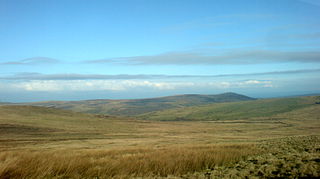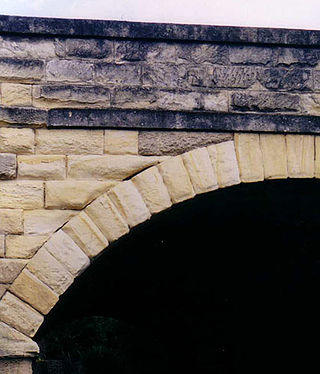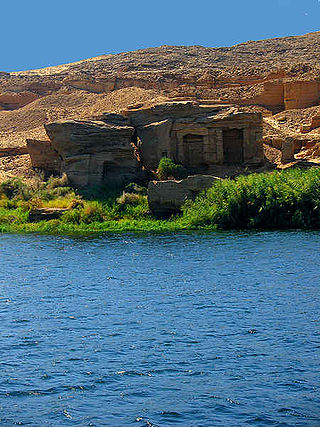
Stonehenge is a prehistoric megalithic structure on Salisbury Plain in Wiltshire, England, two miles (3 km) west of Amesbury. It consists of an outer ring of vertical sarsen standing stones, each around 13 feet (4.0 m) high, seven feet (2.1 m) wide, and weighing around 25 tons, topped by connecting horizontal lintel stones. Inside is a ring of smaller bluestones. Inside these are free-standing trilithons, two bulkier vertical sarsens joined by one lintel. The whole monument, now ruinous, is aligned towards the sunrise on the summer solstice and sunset on the winter solstice. The stones are set within earthworks in the middle of the densest complex of Neolithic and Bronze Age monuments in England, including several hundred tumuli.

The Preseli Mountains, also known as the Preseli Hills, or just the Preselis, is a range of hills in western Wales, mostly within the Pembrokeshire Coast National Park and entirely within the county of Pembrokeshire.

Bedd Arthur is a possibly Neolithic hengiform monument megalithic site in the Preseli Hills in the Welsh county of Pembrokeshire. Thirteen upright stones and at least 2 fallen ones, each around 0.6 metres (2.0 ft) high form an oval horseshoe with similarities to the earliest form of Stonehenge.

Diabase, also called dolerite or microgabbro, is a mafic, holocrystalline, subvolcanic rock equivalent to volcanic basalt or plutonic gabbro. Diabase dikes and sills are typically shallow intrusive bodies and often exhibit fine-grained to aphanitic chilled margins which may contain tachylite.

Oamaru stone, sometimes called whitestone, is a hard, compact limestone, quarried at Weston, near Oamaru in Otago, New Zealand.

Mynachlog-ddu is a village, parish and community in the Preseli Hills, Pembrokeshire, Wales. The community includes the parish of Llangolman.
Michael Parker Pearson, is an English archaeologist specialising in the study of the Neolithic British Isles, Madagascar and the archaeology of death and burial. A professor at the UCL Institute of Archaeology, he previously worked for 25 years as a professor at the University of Sheffield in England, and was the director of the Stonehenge Riverside Project. A prolific author, he has also written a variety of books on the subject.

Carn Menyn is a grouping of craggy rock outcrops or tors in the Preseli Hills in the Welsh county of Pembrokeshire.

Hamstone is a honey-coloured building stone from Ham Hill, Somerset, England. It is a well-cemented medium to coarse grained limestone characterised by marked bedding planes of clay inclusions and less well-cemented material which weather differentially to give exposed blocks a characteristic furrowed appearance. In origin, Hamstone is a Jurassic limestone from the Toarcian, or Upper Lias, stage.
In Arthurian legend, Mount Killaraus is a legendary place in Ireland where Stonehenge originally stood. According to the narrative presented in Geoffrey of Monmouth's Historia Regum Britanniae, King Ambrosius Aurelianus embarks on a quest to construct a memorial for the Celtic Britons who were treacherously slain by Anglo-Saxons. When conventional methods fail to produce an awe-inspiring monument, Ambrosius turns to the renowned wizard Merlin for guidance. In response, Merlin advises the king to transport a stone circle known as the Giant's Ring from Mount Killaraus in Ireland, attributing magical and healing properties to these stones, which were believed to have been brought from Africa by giants.

The geology of Wales is complex and varied; its study has been of considerable historical significance in the development of geology as a science. All geological periods from the Cryogenian to the Jurassic are represented at outcrop, whilst younger sedimentary rocks occur beneath the seas immediately off the Welsh coast. The effects of two mountain-building episodes have left their mark in the faulting and folding of much of the Palaeozoic rock sequence. Superficial deposits and landforms created during the present Quaternary period by water and ice are also plentiful and contribute to a remarkably diverse landscape of mountains, hills and coastal plains.

The stone quarries of ancient Egypt once produced quality stone for the building of tombs and temples and for decorative monuments such as sarcophagi, stelae, and statues. These quarries are now recognised archaeological sites. Ancient quarry sites in the Nile valley accounted for much of the limestone and sandstone used as building stone for temples, monuments, and pyramids. Eighty percent of the ancient sites are located in the Nile valley; some of them have disappeared under the waters of Lake Nasser and some others were lost due to modern mining activity.

Stonehenge has been the subject of many theories about its origin, ranging from the academic worlds of archaeology to explanations from mythology and the paranormal.
The building stones of Wales are many and varied reflecting the diverse geology of the country. Some of the earliest known use of natural stone for building purposes was the sourcing of Ordovician dolerite in the Preseli Hills for the 'bluestone' lintels of Stonehenge. Other early use was in the construction of dolmens, burial cairns and stone circles in the late Stone Age and Bronze Age. The tradition of building in stone was continued into Iron Age with the establishment of such hill forts as those at Tre'r Ceiri in North Wales and Garn Goch in the south.
Craig Rhos-y-felin is a rocky outcrop on the north side of the Preseli Mountains in Wales, which is designated as a RIGS site on the basis of its geological and geomorphological interest. It is accepted by some in the archaeological community that it is the site of a quarry, used together with one at Carn Goedog, for gathering stones used at Stonehenge, most notably as the source of some of the foliated rhyolite found in the Stonehenge "debitage". This is disputed by others, who believe that all of the features at the site, apart from evidence of intermittent occupation over a long period, are of natural origin. Some believe that the site was used as a quarry in both the Neolithic and Bronze Ages, around 4000 to 5000 years ago, and the rock's shape, like a pillar, allowed the stones to be quarried with relative ease compared to stones taken from other places. Others argue that if prehistoric men had wanted to obtain monoliths for use as standing stones, all they had to do was collect them from the abundant glacial erratics littering the landscape.

The Derbyshire Dome is a geological formation across mid-Derbyshire in England.

Waun Mawn is the site of a possible dismantled Neolithic stone circle in the Preseli Mountains of Pembrokeshire, Wales. The diameter of the postulated circle is estimated to be 110 m (360 ft), the third largest diameter for a British stone circle.
The geology of Pembrokeshire in Wales inevitably includes the geology of the Pembrokeshire Coast National Park which extends around the larger part of the county's coastline and where the majority of rock outcrops are to be seen. Pembrokeshire's bedrock geology is largely formed from a sequence of sedimentary and igneous rocks originating during the late Precambrian and the Palaeozoic era, namely the Ediacaran, Cambrian, Ordovician, Silurian, Devonian and Carboniferous periods, i.e. between 635 and 299 Ma. The older rocks in the north of the county display patterns of faulting and folding associated with the Caledonian Orogeny. On the other hand, the late Palaeozoic rocks to the south owe their fold patterns and deformation to the later Variscan Orogeny.

















